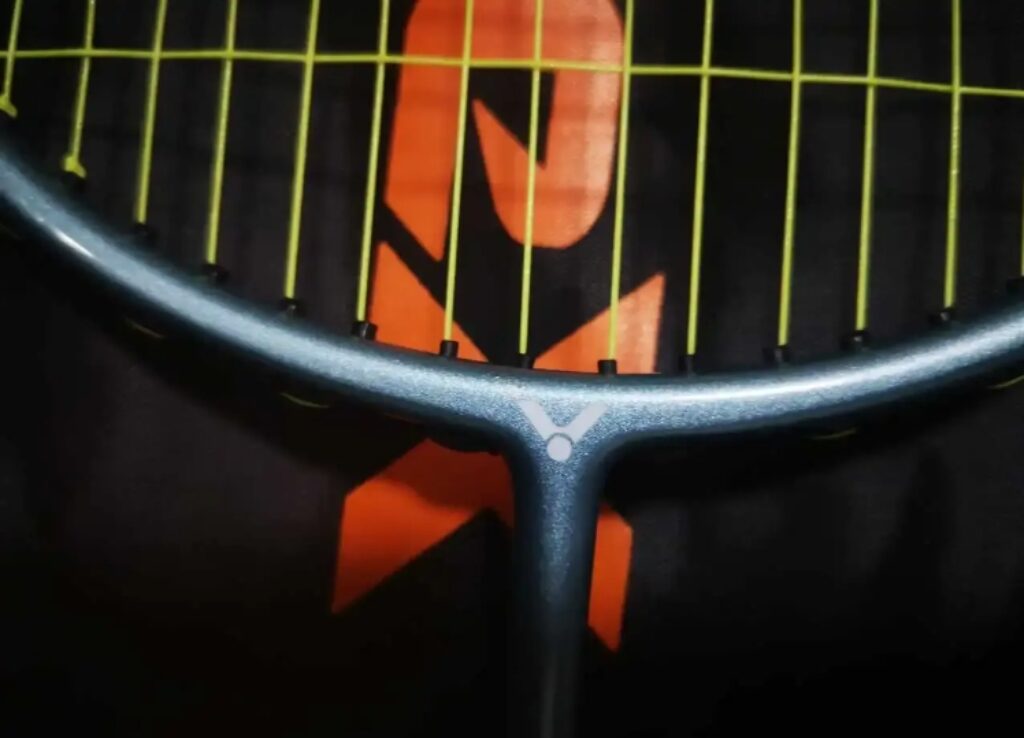Badminton players who have used the Nano 6/7 are likely around forty by now. Well, at least I hit the mark myself. The fact that the original versions of these two rackets are still being sold and even have counterfeit versions is quite unbelievable. Although I haven’t used the original Nano 6, there’s no need to go out of my way to find an old mid-range racket just to knock it down, especially since Victor knows to at least give it a new look and rebrand it as the HypernanoX series to sell.
But now, there’s an even better upgraded version.

Specifications: 3UG5, without the base grip, total weight 91.6g in use, balance point 299mm, 6.6mm shaft, length 210mm, medium stiffness, dynamic hexagonal frame, 8–4 o’clock string grooves, 76-hole string bed, warranty for 28 lbs, strung at 26–28 lbs with VBS66N.
With this IP in hand, it’s a waste not to use it. One of the most classic elements of the Nano 6 IP is the rose gold color scheme, and now the Yu Nano 6 has been fine-tuned to make it look even better. When the Nano 6 was released, the iPhone 4 hadn’t even come out yet! Isn’t Victor leading the trend with this move? Compared to the clunky old version, the new Yu series indeed looks and feels much more premium.

By the way, even though durability is a significant feature, this review won’t cover its sturdiness, as I didn’t get the chance to test it, and I hope players who have had racket clashes won’t actually use it for revenge matches.
That said, although the 3U DXN6 still follows the Yu series’ balanced tuning strategy inherited from the old Nano, it feels a bit weighty when swung. You can’t expect it to be a speed racket just because it has a low balance point and a rounded frame. It’s not a racket that can accelerate at any moment. Besides that, the frame stability, sweet spot forgiveness, and power absorption are all in line, making it relatively easy to handle.
People often say the old Nano felt wooden, and the main reason for that was the shaft’s lack of elasticity. To address this flaw, Victor seems to have made a significant move by fitting it with a 6.6mm shaft, boldly writing this information on the cone in large black font, as if to say, “Who’s still calling me wooden?” But as for the actual experience…

Thanks to the quirky anti-rebound carbon tube technology, the DXN6 still feels wooden, almost like the HX100. The old Nano is comforted, its spirit lives on… Jokes aside, during the initial use of the new racket, the shaft’s performance was not fully activated. After about half an hour of play, the feedback felt more natural. The racket offers a slightly noticeable ball-holding sensation, feeling a bit soft, which is also a classic feature of the old Nano, but it still retains a solid feeling, making it somewhat enjoyable to use.
After breaking it in, during powerful smashes, you’ll experience a sensation similar to NAMD, where the racket’s hardness slightly increases upon impact. With the string tension at 26–28 lbs, the feedback from the string bed is quite clear, so the smash feeling isn’t vague. The significance of the 6.6mm shaft upgrade becomes evident at this moment. For players with good explosive power, the upper limit of the Yu Nano 6 is quite high, ranking in the upper-mid range of mid-tier rackets, not inferior to those featuring Pyrofil carbon.

However, this also raises the bar for players when using the Yu Nano 6 for downward attacks. It’s not as easy as it looks. While it accommodates the more abrupt burst of power during impact, relying solely on the racket’s weight to leisurely execute a downward offensive shot is much less satisfying. Especially towards the end of a match, using this racket demands a certain level of fitness.
But since it’s equipped with a dynamic hexagonal frame, and the overall thickness of the frame has been significantly reduced—especially with the thickness at the 12 o’clock position close to the speed series—it seems Victor has found a way to improve the flexibility of the Nano 6. Just when I was confidently speeding up in doubles, I regretted it—the performance in fast exchanges is still quite ordinary, not quite what I expected. Perhaps the 4U version might improve this, but the old Nano was never a speed-oriented racket, so I’ll pass.

You may not excel at fast exchanges, but you can control the game effectively. The Yu series’ frame design is indeed geared towards stability, and the Nano 6, with its solid feel, offers excellent stability. The feel at the net is very solid, and the quality of net drops, slices, lifts, and blocks can quickly reach a high level. Although due to the swing weight, I don’t particularly enjoy using it for cross-court shots or deceptive moves, for players with a higher demand for shot precision, the Yu Nano 6’s ability to execute shot commands is on par with high-end rackets. Slow things down a bit, and everything will be great.
The old Nano has almost become a major IP for Victor. After upgrading its materials in the new era, its performance has indeed improved significantly, but so have the skills and patience required to handle it. It’s worth buying, but after purchasing, you’ll need to spend more time playing with it, adapting to it, and gradually appreciating its merits.


Leave a Reply